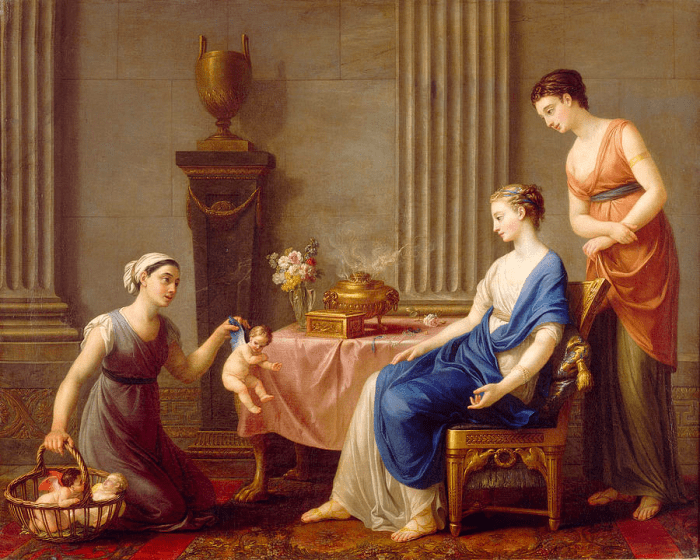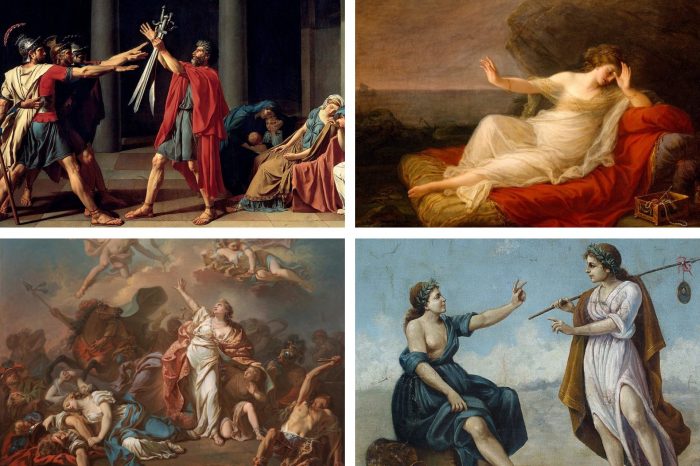The figures in neoclassical paintings were largely idealized representations of the human form, often inspired by classical Greek and Roman sculpture. These figures played a significant role in conveying the moral and philosophical messages of neoclassical art, and their influence can still be seen in contemporary art today.
Neoclassical painting emerged in the mid-18th century as a reaction against the excesses of the Baroque and Rococo periods. Neoclassical artists sought to revive the classical ideals of beauty, harmony, and restraint. They believed that the human form was the perfect expression of these ideals, and they used it as the primary subject matter in their paintings.
Neoclassical Painting: An Overview

Neoclassicism, a prominent art movement that emerged in the late 18th century, sought to revive the ideals and principles of classical Greek and Roman art. This movement rejected the ornate and excessive style of the preceding Rococo period, emphasizing instead simplicity, balance, and clarity.
Define neoclassicism in art
Neoclassicism in art is characterized by its focus on idealized forms, rational composition, and a revival of classical motifs and themes. Artists sought to emulate the perceived perfection and harmony of ancient Greek and Roman art, which they believed embodied the highest ideals of beauty and truth.
Discuss the historical context of neoclassical painting
The rise of neoclassicism coincided with the Enlightenment, a period of intellectual and philosophical change that emphasized reason and rationality. Artists of this era sought to create art that reflected these Enlightenment values, promoting civic virtue and moral exemplars through their depictions of classical subjects and idealized human forms.
Explain the key characteristics of neoclassical paintings
Key characteristics of neoclassical paintings include:
- Emphasis on idealized human forms, often inspired by classical Greek and Roman sculpture
- Simple and balanced compositions, with clear geometric structures and a focus on harmony and proportion
- Use of classical motifs and themes, such as mythology, history, and allegory
- Subtle and restrained color palettes, often dominated by earthy tones and muted hues
Figures in Neoclassical Paintings

Explain the significance of figures in neoclassical paintings
Figures play a central role in neoclassical paintings, serving as vehicles for conveying moral lessons, historical narratives, and allegorical meanings. Artists carefully depicted figures to embody the idealized human form, reflecting the classical belief in the perfection and beauty of the human body.
Discuss the different types of figures depicted in neoclassical paintings
Neoclassical paintings depict a wide range of figures, including:
- Gods and goddesses:Figures from Greek and Roman mythology were often depicted to represent virtues, vices, or specific aspects of human nature.
- Historical figures:Artists used historical figures to illustrate moral lessons or commemorate significant events.
- Allegorical figures:Personifications of abstract concepts, such as Liberty, Justice, or Truth, were often used to convey symbolic meanings.
- Everyday people:Neoclassical artists also depicted everyday people, often engaged in simple and virtuous activities, to promote moral values and social harmony.
The Idealized Human Form in Neoclassicism
Explain the concept of the idealized human form in neoclassical art
Neoclassical artists sought to depict the idealized human form, which they believed represented the pinnacle of physical and moral perfection. This idealized form was based on the study of classical Greek and Roman sculpture, which emphasized balance, proportion, and harmony.
Discuss the influence of classical Greek and Roman sculpture on neoclassical figures
Classical Greek and Roman sculpture had a profound influence on the depiction of figures in neoclassical paintings. Artists studied these sculptures to learn about the ideal proportions and poses of the human body. They also adopted the classical contrapposto stance, in which the figure’s weight is shifted to one leg, creating a sense of movement and dynamism.
Provide examples of neoclassical paintings that demonstrate the idealized human form, The figures in neoclassical paintings were largely
Examples of neoclassical paintings that demonstrate the idealized human form include:
- The Oath of the Horatiiby Jacques-Louis David
- The Death of Socratesby Jacques-Louis David
- Venus de Miloby Alexandros of Antioch
Composition and Figures in Neoclassical Paintings: The Figures In Neoclassical Paintings Were Largely

Explain the role of composition in neoclassical paintings
Composition plays a crucial role in neoclassical paintings, helping to convey the artist’s message and create a sense of balance and harmony. Artists carefully arranged figures within the composition to create a visually pleasing and meaningful image.
Discuss how figures are arranged and grouped within neoclassical compositions
Figures in neoclassical paintings are often arranged in geometric patterns, such as triangles or circles. This arrangement creates a sense of order and stability. Artists also used grouping to create relationships between figures and to convey different meanings. For example, figures grouped together may represent unity or friendship, while figures separated by space may represent isolation or conflict.
Provide examples of neoclassical paintings that illustrate effective use of composition
Examples of neoclassical paintings that illustrate effective use of composition include:
- The Raft of the Medusaby Théodore Géricault
- The Bathersby Jean-Auguste-Dominique Ingres
- The Apotheosis of Homerby Jean-Auguste-Dominique Ingres
Symbolism and Figures in Neoclassical Paintings
Explain the use of symbolism in neoclassical paintings
Neoclassical artists often used symbolism to convey deeper meanings and messages. Figures could represent abstract concepts, such as virtues or vices, or they could symbolize specific historical events or mythological narratives. Artists carefully selected objects, gestures, and poses to create a rich and complex layer of symbolism.
Discuss how figures are used to convey symbolic meanings
Figures in neoclassical paintings can convey symbolic meanings through various means, including:
- Attributes:Figures may be depicted with specific attributes, such as a sword or a laurel wreath, to symbolize their identity or role.
- Gestures:Gestures can convey a wide range of emotions and meanings, from triumph to despair.
- Poses:The pose of a figure can also be symbolic, representing strength, vulnerability, or other qualities.
Provide examples of neoclassical paintings that use figures to convey specific symbols or messages
Examples of neoclassical paintings that use figures to convey specific symbols or messages include:
- Liberty Leading the Peopleby Eugène Delacroix
- Napoleon Crossing the Alpsby Jacques-Louis David
- The Death of Maratby Jacques-Louis David
The Legacy of Neoclassical Figures

Discuss the influence of neoclassical figures on later art movements
Neoclassical figures have had a profound influence on subsequent art movements, including Romanticism, Realism, and Modernism. Romantic artists adopted the idealized human form and dramatic gestures of neoclassical figures, while Realists used them to depict everyday life and social issues.
Modernists, such as Pablo Picasso and Henri Matisse, reinterpreted neoclassical figures to create new and innovative forms of art.
Explain how neoclassical figures have been interpreted and reinterpreted over time
Neoclassical figures have been interpreted and reinterpreted over time to reflect the changing values and beliefs of different societies. For example, during the French Revolution, neoclassical figures were used to represent the ideals of liberty, equality, and fraternity. In the 20th century, neoclassical figures were often used to critique social and political issues.
Provide examples of contemporary art that references or draws inspiration from neoclassical figures
Examples of contemporary art that references or draws inspiration from neoclassical figures include:
- The Bathersby David Hockney
- The Death of Maratby Jeff Koons
- The Raft of the Medusaby Damien Hirst
Question & Answer Hub
What is neoclassicism?
Neoclassicism is an art movement that emerged in the mid-18th century as a reaction against the excesses of the Baroque and Rococo periods. Neoclassical artists sought to revive the classical ideals of beauty, harmony, and restraint.
What is the significance of figures in neoclassical paintings?
Figures played a significant role in neoclassical paintings. They were often idealized representations of the human form, and they were used to convey the moral and philosophical messages of neoclassical art.
How are figures arranged in neoclassical paintings?
Figures in neoclassical paintings are often arranged in a symmetrical and balanced composition. This reflects the neoclassical emphasis on order and harmony.